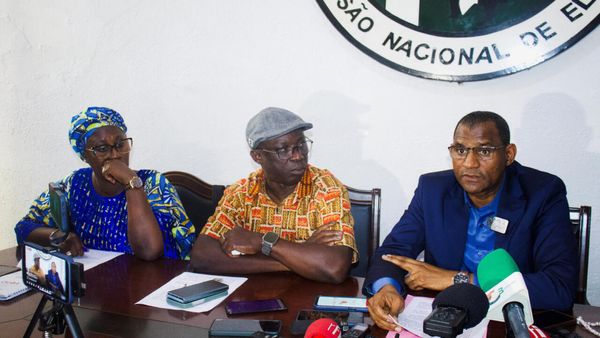
Four months ago, Dr Nubwa Medugu took a call from a colleague in the hospital she works at in Abuja, Nigeria, asking her to come and see a six-year-old girl who had undergone cardiac surgery. Abeni (not her real name) had been prescribed antibiotics, but they weren’t working.
Medugu, who specialises in clinical biology and infectious diseases, found Abeni in a bad state; she had a fever, her heart rate was high, and her breathing was fast and shallow.
Medugu took blood, sent it off to get tested, and found that Abeni was infected by a bacteria resistant to several antibiotics. “There was nothing that would work,” remembers Medugu. “The only thing that might come close was [an antibiotic called] tigecycline.”
There were no supplies of tigecycline in the hospital, so they had to get it flown in from Lagos. After it was administered, Abeni’s condition improved slightly, but then deteriorated. Three days later, she was dead. “It still haunts my dreams,” says Medugu. “A lot of deaths do that, especially when they could have been [prevented].”
Medugu regularly sees cases where antibiotics don’t work on a patient because their infection has developed resistance. Since she started her career in 2007, she has seen a rise in such cases. Worldwide, millions of deaths happen every year as a result of antibiotic-resistant bacterial infections, and numbers are rising faster than expected.
The highest rates of antimicrobial resistance (AMR), where bacteria survive in the presence of a drug that once killed them, are in sub-Saharan Africa. According to the global research on antimicrobial resistance report, deaths caused directly by AMR were estimated at 24 per 100,000 population in sub-Saharan Africa in 2019, nearly double the rate in high-income countries, where AMR led directly to 13 deaths per 100,000.
AMR is one of the top 10 global public health threats facing humanity, according to the World Health Organization. It could kill 4.1 million people across Africa by 2050. Developing countries across Africa could lose up to 5% of their GDP as a result of AMR, a worse financial toll than the 2008 financial crisis.
“The situation in the African region is really concerning,” says Dr Mirfin Mpundu, director of ReAct Africa, a network aimed at raising awareness of AMR. “The number of people who are dying where we can’t treat them because we don’t have antibiotics that destroy or kill [the pathogen causing the infection] is far greater than the deaths recorded for malaria, TB and HIV/Aids combined.”
Lack of access to medicine is a major driver of AMR in sub-Saharan Africa. The world’s poorest countries have the greatest rates of infectious disease and the highest levels of antibiotic resistance – and also the biggest gaps in access to the right treatment, says Marijn Verhoef, director of operations and research for the Access to Medicine Foundation.
“In sub-Saharan Africa, in most regions, either patients have no access to medicine at all or access to suboptimal treatments – either antibiotics for a different type of infection, falsified medicines or antibiotics reserved for treating the most difficult infections,” he says.
Medugu has seen this first-hand in her hospital in Abuja. A recent study she conducted with Fred C Tenover, a professor of microbiology at the University of Dayton in the US, found that about 85% of the bacteria isolated from blood and urinary tract infections in six hospitals in Nigeria were resistant to the most commonly used antibiotics. In addition, 65% of the bacteria analysed were resistant to the “antibiotics of last resort”, reserved for treating the most difficult infections.

Photograph: Photo 12/Alamy
“Antibiotics are hard to get,” she says. “In addition, you have the problem of affordability. Sometimes [patients] are not able to buy them so doctors and nurses contribute money … but there’s only so much staff can do to support.”
Fake antibiotics are another problem. Large criminal networks flood the global market with counterfeit medicine that looks genuine and is cheaper, making it an attractive option for people on low incomes. “There are a lot of fake and substandard medicines circulating,” says Medugu. “The problem is that many people self-prescribe. If you go to hospital, you pay bills to see the doctor. The queues are long, and lab tests are expensive. People would rather go to the chemist because it’s easier and cheaper.”
Healthcare systems across sub-Saharan Africa are weak, adds Mpundu, and lab infrastructure is poor. “We don’t know what we are treating because we are unable to grow bacteria in the lab and see what antibiotics they respond to,” he says.
Poor waste management practices, where refuse spills from hospitals and gets into the environment, including water sources, are another contributing factor, as is poor sanitation. One in four healthcare facilities globally is without clean water on site, and one in three has nowhere for staff to wash their hands.
Although awareness of AMR is increasing, many remain ignorant of the dangers it poses. There will be a high-level meeting on AMR next year at the UN general assembly, but Verhoef says raising awareness is “difficult because there’s no typical patient. It’s a difficult topic, storytelling wise. There are no celebrities related to it, and we’re not in a lockdown.”
According to the WHO, almost all African countries have national AMR plans. But in many, the “level of implementation does not match the magnitude of the problem”, says Mpundu. Investment at a time when health budgets are declining is critical, he adds. Vaccinations are also key, but immunisation rates have fallen.
Despite the challenges, Mpundu remains “cautiously optimistic”. At the UN meeting next year, he hopes that more countries will prioritise fighting AMR.
For Verhoef, there is no single solution, and success depends on multiple factors. “We have learned from Covid that diseases have no borders. There are different circumstances that are not in favour of humans in the human v superbug battle, whether it’s the spread of migration or the climate that changes in a beneficial way for bacteria.
“We will need patients, doctors, pharmacists, policymakers, companies, farmers and vets to step up.”







